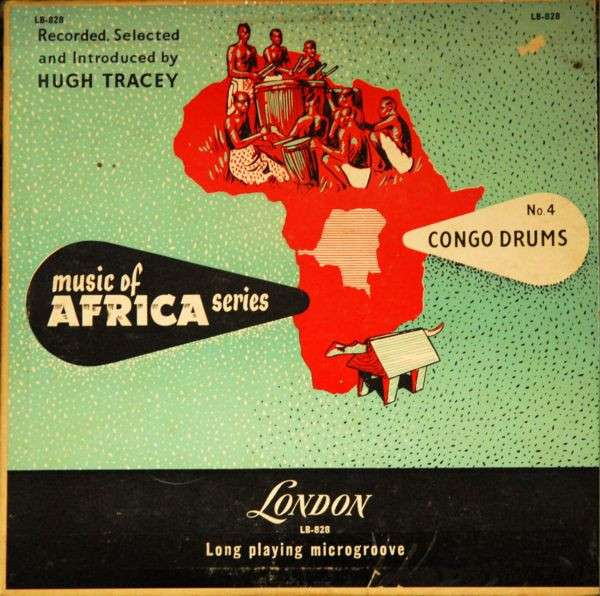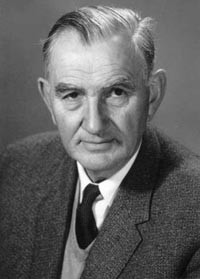
Hugh Tracey
Congo Drums
Album UK 1952 on London Records label
Spoken Word, Folk, World and (Field Recording, African)
Made in England Talking Drums -- Side 1 A description and demonstration of the Talking Drums of the Lokele Tribe of the Upper Congo, by Hugh Tracey and the Rev. W. Ford, with two Lokele drummers, Sisiri and Kiokio. It is popularly supposed that all Africans use message drums for talking to each other at great distances. This is not so and the art of sending messages by means of the two-toned slit-drum is confined, in Africa south of the Equator, to a narrow strip of country along the banks of the great Congo River and its higher tributaries the Lualaba and Luapula. A mere hundred miles away from the river the sending of messages is unknown and the information tapped out by drum has degenerated into signals only. It is only along the river itself that the people can convey understandable messages to each other without a prearranged code which is essential in the case of all signalling. The secret of drum messages lies in the use of the two toned sytem of the native language reflected in the two toned drum and a careful use of synonyms to avoid confusion between words or short phrases having the same tone melody and rhythm. In West Africa, north of the Equator, two membrane drums are used for the same purpose. The Rev. W. Ford explains clearly and dinstinctly how drum messages are sent and answered and his remarks are illustrated by the two Lokele drummers. It will be noticed that sometimes the drummers have made obvious minstakes in the illustrations. This was due to their not understanding English coupled with the fact that they had never been asked to do such a thing before. The geniusness of their drumming however can be clearly heard at the end of the recording when they were told to go ahead on their own, calling out the words they were sending. Anyone who visits the Congo in the neighborhood of Stanleyville, which is the home of the river tribe, the Lokele, will hear drum messages on almost any evening and early in the mornings when the fisherman are preparing to set out for their day's work. Talking drums fascinated the early explorers of Africa as Europe, with all her science, had only recently perfected the Morse code. Until that time Africa was ahead of the civilised world in this single phenomenon, the sending of intelligible messages beyond the range of human voice and out of sight of the recipient of your message. Sitting out of doors in the evening with the broad Congo sliding silently by, you are almost certain to hear drum conversations between villages on either side of the river. Indeed it may have been the very width of the Congo itself which gave rise to the art of message drumming. People who worked together in their canoes fishing all day long were not sharply divided by the river. They would be familiar with their friends and relatives of the same tribe and language who lived on the bank.The necessity for common defense, the gossip of the district and the constant coming and going of the trading canoes from down river and latterly, as Stanley himself reported, the appearance of strange craft containing white skinned men, all encouraged by the use of man's first broadcasting system for both utilitarian and pleasurable ends. One writer has likened the sound of distant message drums in the night to "the murmur of human voices on the verandah outside your door." Imagination could easily run riot in those days when the country was still hostile to strangers. Other means of communication and the blessings of peace brought by the white men have now undermined the necessity for drum messages and the art is gradually receding on the Congo. This recording therefore will be of great historical interest in years to come. Royal Tutsi Drums -- Side II The Royal Kalinga Drummers of the Mwami of Ruanda -- Mutara III Rudahigwa of the Tutsi Tribe. The full set of seven drum rhythms played by the Royal Drummers under their leader, Sehene. The brilliance of the panoply of African Chiefs which has been handed down by tradition for many generations, if not for centuries, has suffered extensively from the intrusion of Europeans into the continent and in particular from the enforced peace which they brought with them. War was ever the great integrator of tribes and leadership the key to survival in a hostile country. Leadership to be effective, as we know, must inspire confidence and fire the imagination of its followers or it will not be able to command their loyalty at the critical moment of battle and their obedience to the proven laws of social survival in the gentler hours of peace. African men with this knowledge deeply ingrained in their souls have constantly searched their countryside for appropriate symbols with which to raise the dignity of the leader above that of the common herd. The feathers of rare birds, the skins of dangerous animals and the craft of sculptors and musicians have all been applied to this task. The music of royal bands has long been a feature of the 'kingship' principal and may still be heard in the more integrated chieftainships of central and southern Africa before the levelling hand of industrialization and democracy has robbed them of their individuality. The royal drums are an essential part of the panoply of the small kingdom of Ruanda and its artisocratic caste of rulers, the Tusi overlords. It is believed that this pastoral tribe came down from the north with their long-horned sacred cattle, from somewhere in Ethiopia about the twelfth century, establishing themselves among the Hutu tribe of Bantu and the Batwa Pygmoids, including both in their feudal system of government. The Tutsi themselves are unusually tall, their menfolk frequently grow to 7 feet. Their young men who dance the famous and graceful Ntore dances do so to the sound of horns and drums played by their diminutive subjects. The most renowned of the dancers were young squires at the court of the Mwami, the absolute ruler of the whole kingdom of Ruanda. It is part of the ritual of this court and the function of Hutu musicians to maintain and play the royal Kalinga drums, which are recorded here. The set of royal tattoos which they sound still invoke sincere feelings of loyalty to the house of the Mwami and of patriotism for this highland country from the whole tribe, Tutsi, Hutu and Batwa alike. The names of the seven drum rhythms are announced by one of the drummers before each item. They are: I. Zirasuka II. Urukina III. Umuterero IV. Imirindi V. Ikimanura VI. Agariga VII. Ikirushyo (Note -- the 'k' in 'Ukurina,' 'Ikimanura' and 'Ikirushyo' is pronounced 'ch' as in English 'chit.') The four drummers dressed in yellow, white and red cloth use heavy beaters shaped like wooden ladles with which to sound their drums. They cut their hair in traditional style into two crescents on opposite sides of the head, the one towards the front and left, the other diagonally opposite. The dancers are perhaps the most renowned in all Africa and add in no small measure to the reputation of their country already rich in historic legend and culture.
Musicians
 | Hugh Tracey voc, 1903-1977 GB recorded by, liner notes, other, selected by, introductions, album by |
 | Royal Kalinga Drummers Of Mwami, Ruanda drums, kalinga |
 | Shene drums, leader |
 | Rev. W. Ford voice, explanation |
 | Kiokio , drums |
 | Sisiri , drums |
Album Tracks
| No | Title | Artist | Composer | Duration |
|---|---|---|---|---|
| 1 | Congo Drums | Hugh Tracey | ||
| 2 | Talking Drums | Hugh Tracey | 14:55 | |
| 3 | Royal Tutsi Drums | Hugh Tracey | 16:04 | |
| 4 | I. Zirasuka | Hugh Tracey | 2:04 | |
| 5 | II. Urukina | Hugh Tracey | 2:48 | |
| 6 | III. Umuterero | Hugh Tracey | 2:03 | |
| 7 | IV. Imirindi | Hugh Tracey | 1:09 | |
| 8 | V. Ikimanura | Hugh Tracey | 2:36 | |
| 9 | VI. Agariga | Hugh Tracey | 2:48 | |
| 10 | VII. Ikirushyo | Hugh Tracey | 2:34 |
